 W
WAntarctosaurus is a genus of titanosaurian sauropod dinosaur from the Late Cretaceous Period of what is now South America. The type species, Antarctosaurus wichmannianus, and a second species, Antarctosaurus giganteus, were described by prolific German paleontologist Friedrich von Huene in 1929. Three additional species of Antarctosaurus have been named since then but later studies have considered them dubious or unlikely to pertain to the genus.
 W
WArganodus is an extinct genus of Ceratodontidae (lungfish). Its fossils have been found in the Redonda Formation, New Mexico, the Tacuarembó Formation of Uruguay, and the Cumnock Formation, North Carolina, although the North Carolinian specimens are smaller than most recorded specimens. Fossils have also been uncovered in the Petrified Forest National Park. It was first named by Martin in 1979, and contains two species, A. dorotheae and A. atlantis. Arganodus was probably similar to modern lungfish, and lived in underwater burrows during dry periods until monsoons occurred.
 W
WCatonyx is an extinct genus of ground sloth of the family Scelidotheriidae, endemic to South America during the Pleistocene epoch. It lived from 2.5 Ma to about 10,000 years ago, existing for approximately 2.49 million years . The most recent date obtained is about 9600 B.P.
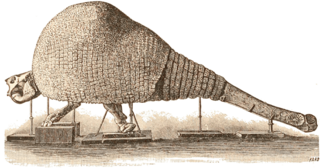 W
WDoedicurus, or Dædicurus, is an extinct genus of glyptodont from South America containing one species, D. clavicaudatus. Glyptodonts are a member of the family Chlamyphoridae, which also includes some modern armadillo species, and they are classified in the order Xenarthra alongside sloths and anteaters. Being a glyptodont, it was a rotund animal with heavy armor and a carapace. Averaging at an approximate 1,400 kg (3,100 lb), it was one of the largest glyptodonts to have ever lived. Though glyptodonts were quadrupeds, large ones like Doedicurus may have been able to stand on two legs like other xenarthrans. It notably sported a spiked tail club, which may have weighed 40 or 65 kg in life, and it may have swung this in defense against predators or in fights with other Doedicurus at speeds of perhaps 11 m/s.
 W
WDusicyon avus is an extinct species of canid in the genus Dusicyon. It was medium to large, about the size of a German shepherd.. It was closely related to the warrah or Falkland Islands wolf, and was the ancestral species from which it diverged. It appears to have survived until very recently, perhaps 400 years ago.
 W
WGlossopteris is the largest and best-known genus of the extinct Permian order of seed ferns known as Glossopteridales. The genus Glossopteris refers only to leaves, within a framework of form genera used in paleobotany. Species of Glossopteris were widespread over the supercontinent of Gondwana during the Permian epoch, where they formed the dominant component of high latitude polar forests. Glossopteris fossils were critical in recognizing former connections between the various fragments of Gondwana: South America, Africa, India, Australia, New Zealand, and Antarctica.
 W
WGlossotherium was a genus of ground sloth. It was a heavily built animal with a length of about 4 metres (13 ft) snout to tail-tip, a weight estimated at 1,000 kg (2,200 lb), and could potentially assume a slight bipedal stance.
 W
WGlyptodon was a genus of large, heavily armored mammals of the subfamily Glyptodontinae – relatives of armadillos – that lived during the Pleistocene epoch. It was roughly the same size and weight as a Volkswagen Beetle. With its rounded, bony shell and squat limbs, it superficially resembled a turtle, and the much earlier dinosaurian ankylosaur – providing an example of the convergent evolution of unrelated lineages into similar forms. In 2016 an analysis of Doedicurus mtDNA found it was, in fact, nested within the modern armadillos as the sister group of a clade consisting of Chlamyphorinae and Tolypeutinae. For this reason, glyptodonts and all armadillos but Dasypus were relocated to a new family, Chlamyphoridae, and glyptodonts were demoted from the former family Glyptodontidae to a subfamily.
 W
WThis is a list of gomphothere fossils found in South America. Gomphotheres were elephant-like mammals that lived from the Middle Miocene to the Holocene.
 W
WHippidion is an extinct genus of horse that lived in South America from the Late Pliocene to the end of the Late Pleistocene (Lujanian), between two million and 11,000 years ago. They were one of two lineages of equines native to South America during the Pleistocene epoch alongside those of the Equus subgenus Amerhippus.
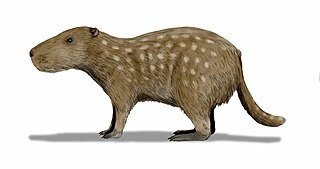 W
WJosephoartigasia is an extinct genus of giant rodent from the Early Pliocene to Early Pleistocene, related to the living pacarana. The genus includes the largest known rodent, Josephoartigasia monesi. The two species would have resembled gigantic pacarana, or capybaras the size of cows, with an estimated weight of 1,000 kg.
 W
WJosephoartigasia monesi, an extinct species of South American caviomorph rodent, is the largest rodent known, and lived from about 4 to 2 million years ago during the Pliocene to early Pleistocene. The species is one of two in the genus Josephoartigasia, the other being J. magna. J. monesi is sometimes called the giant pacarana, after its closest living relative, the pacarana in the family Dinomyidae. The species may have weighed a ton, orders of magnitude larger than any currently living rodent.
 W
WLaplatasaurus is a genus of titanosaurian sauropod dinosaur that lived during the Late Cretaceous in South America.
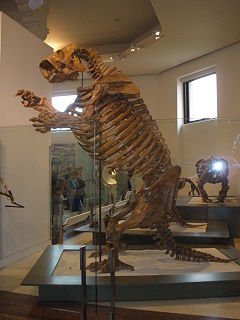 W
WLestodon is an extinct genus of megafaunal ground sloth from South America during the Pliocene to Pleistocene periods. Its fossil remains have been found in Argentina, Paraguay, Uruguay, Venezuela, Bolivia, and Brazil. Measuring approximately 4.6 metres (15 ft) from snout to tail tip, it is estimated to have weighed 2,590 kilograms. It was a herbivore and primarily fed on the grasses on the South American plains and is thought to perhaps have used its semi-bipedal stance to obtain foliage from trees. Lestodon is placed as member of the Mylodontidae as indicated by the lobed form of the last tooth in the dentition.
 W
WMacrauchenia was a large, long-necked and long-limbed, three-toed native South American mammal in the order Litopterna. The genus gives its name to its family, the Macraucheniidae or "robust litopterns". Like other litopterns, it is not closely related to any living mammal, being most closely related to the group containing horses, rhinos and tapirs, from which litopterns diverged approximately 66 million years ago. The oldest fossils in the genus date to the late Miocene, around seven million years ago, and M. patachonica disappears from the fossil record during the late Pleistocene, around 20,000-10,000 years ago. M. patachonica is one of the last and best known member of the family and is known primarily from the Luján Formation in Argentina, but is known from localities across southern South America. Another genus of macraucheniid Xenorhinotherium was present in northeast Brazil and Venezuela during the Late Pleistocene. The type specimen was discovered by Charles Darwin during the voyage of the Beagle. In life, Macrauchenia may have resembled a humpless camel, though the two taxa are not closely related. It fed on plants in a variety of environments across what is now South America. Among the species described, M. patachonica and M. ullomensis are considered valid; M. boliviensis is considered a nomen dubium; and M. antiqua has been moved to the genus Promacrauchenia.
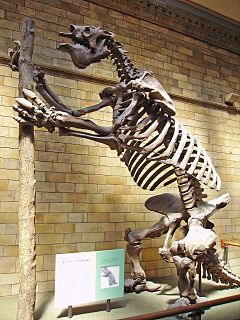 W
WMegatherium is an extinct genus of ground sloths endemic to South America that lived from the Early Pliocene through the end of the Pleistocene. It is best known for the elephant-sized type species M. americanum, sometimes called the giant ground sloth, or the megathere, native to the Pampas through southern Bolivia during the Pleistocene. Various other smaller species belonging to the subgenus Pseudomegatherium are known from the Andes. Megatherium is part of the sloth family Megatheriidae, which also includes the similarly elephantine Eremotherium, which was native to tropical South America and southern North America. Only a few other land mammals equaled or exceeded M. americanum in size, such as large proboscideans and the giant rhinoceros Paraceratherium. Megatherium was first discovered in 1788 on the bank of the Luján River in Argentina. The holotype specimen was then shipped to Spain the following year wherein it caught the attention of the esteemed paleontologist Georges Cuvier, who was the first to determine, by means of comparative anatomy, that Megatherium was a sloth. Megatherium became extinct around 12,000 years ago during the Quaternary extinction event, which also claimed most other large mammals in the New World. The extinction coincides with the settlement of the Americas, and a kill site where a M. americanum was slaughtered and butchered is known, suggesting that hunting could have caused its extinction.
 W
WMesosaurus is an extinct genus of reptile from the Early Permian of southern Africa and South America. Along with it, the genera Brazilosaurus and Stereosternum, it is a member of the family Mesosauridae and the order Mesosauria. Mesosaurus was long thought to have been one of the first marine reptiles, although new data suggests that at least those of Uruguay inhabited a hypersaline water body, rather than a typical marine environment. In any case, it had many adaptations to a fully aquatic lifestyle. It is usually considered to have been anapsid, although Friedrich von Huene considered it to be a synapsid, and this hypothesis has been revived recently.
 W
WNeolicaphrium is an extinct genus of ungulate mammal belonging to the extinct order Litopterna. This animal lived from the Late Pliocene (Chapadmalalan) to the Late Pleistocene (Lujanian) in southern South America, being the last survivor of the family Proterotheriidae.
 W
WNeuquensaurus is a genus of saltasaurid sauropod dinosaur that lived in the Late Cretaceous, about 80 million years ago in Argentina and Uruguay in South America. Its fossils were recovered from outcrops of the Anacleto Formation around Cinco Saltos, near the Neuquén river from which its name is derived.
 W
WPanochthus is an extinct genus of glyptodont, which lived in the Gran Chaco-Pampean region of Argentina, Brazil, Bolivia, Paraguay and Uruguay during the Pleistocene epoch.
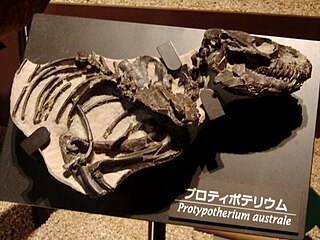 W
WProtypotherium is an extinct genus of notoungulate mammals native to South America during the Miocene epoch. A number of closely related animals date back further, to the Paleocene. Fossils of Protypotherium have been found in the Deseadan Fray Bentos Formation of Uruguay, Muyu Huasi Formation of Bolivia, Cura-Mallín and Río Frías Formations of Chile, and Santa Cruz, Salicas, Ituzaingó, Cerro Bandera, Chichinales, Sarmiento and Collón Curá Formations of Argentina.
 W
WScarrittia is an extinct genus of hoofed mammal of the family Leontiniidae, native to South America during the Late Oligocene epoch.
 W
WToxodon is an extinct genus of South American mammals from the Late Miocene to early Holocene epochs. It is a member of Notoungulata, one of several now extinct orders of hoofed mammals indigenous to South America. It was among the largest and last members of its order, and was probably the most common large hoofed mammal in South America of its time.
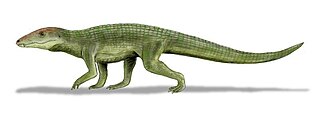 W
WUruguaysuchus is an extinct genus of crocodylomorphs from the Late Cretaceous Guichón Formation of Uruguay. It was related to Simosuchus and Malawisuchus. It was of small to moderate size reaching an estimated length of 120 centimetres (3.9 ft).